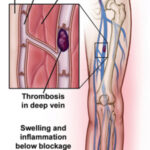Leg numbness, or the sensation which occurs when the leg “falls asleep,” can be very uncomfortable. If the leg goes numb frequently, it is likely due to a medical condition. Here are some of the potential causes of leg numbness.
Deep Vein Thrombosis (DVT)
DVT occurs when a blood clot is formed in a deep vein. It is most common for these blood clots to form in the calf or deep vein. Some of the symptoms of deep vein thrombosis aside from leg numbness include leg swelling, leg pain or tenderness and visible veins in the leg. The skin of the leg which is affected may be warm and red or discolored.
Peripheral Arterial Disease (PAD)
This condition occurs when fatty deposits block the leg’s blood vessels, which prevents regular blood flow to the feet and legs. According to the American Diabetes Association, individuals who have diabetes are at an increased risk of experiencing PAD. Other symptoms of peripheral artery disease include leg pain which commonly occurs when walking or exercising, leg infections or sores which don’t heal right away and leg or feet tingling and/or coldness.
Restless Legs Syndrome (RLS)
RLS sufferers experience uncomfortable tingling, tugging, burning or otherwise uncomfortable sensations in their thighs, calves, feet and even arms. It is common for leg numbness to occur when individuals are sitting or laying down, and are generally relieved by getting up and moving. Some people who suffer from restless legs syndrome may also experience leg twitching or kicking at night.
Multiple Sclerosis (MS)
MS sufferers may experience numbness or tingling early on. Other symptoms that they may suffer from early on include limb weakness, a loss of balance and vision problems. They may also have cognitive and coordination problems, slurred speech and sudden, unexplained paralysis. When multiple sclerosis worsens, individuals suffer from fatigue, heat sensitivity, muscle spasms, speech problems, difficulty swallowing, dizziness and tremors. It is common for MS to occur between the ages of 20 and 40.
Tarsal Tunnel Syndrome
People who suffer from tarsal tunnel syndrome are more likely to recognize numbness in their feet than in their legs. Individuals may feel a tingling and burning or painful sensation that begins in their heel and may extend to the toes. Risk factors of the condition include a fracture, inflammatory arthritis (such as rheumatoid arthritis) and abnormal foot function. According to Merck, hypothyroidism sufferers may experience symptoms similar to tarsal tunnel syndrome.
Keep in mind that this information is not meant to replace the advice of a doctor. If you experience leg numbness on a regular basis, it is important to speak with a physician. It is important to get a proper diagnosis so that you will be able to begin treatment.
Sources:
American Diabetes Association, “Peripheral Arterial Disease.”
Mayo Clinic, “Restless legs syndrome.
Merck, “Tarsal Tunnel Syndrome.”
Web MD, “Multiple Sclerosis: Recognizing Multiple Sclerosis.”
Web MD, “Symptoms and Diagnosis of Deep Vein Thrombosis.”





